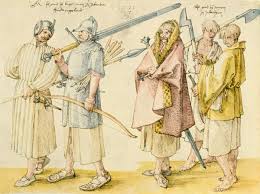McCoy Ancestry and the Legend of the Gallóglaigh
Introduction to the McCoy Family
My name, Kyle McCoy has a lot of meaning to me. A couple years back, I decided to take the time out to research my family's history and the meaning of the MCCOY family name. I found out that MCCOY was one of many Scots-Gaelic Families, and that MC means Son of, and COY is the Gaelic God of Fire.
This means that my name means Son of Coy, and in theory, my family is decsended from the gaelic god of Fire!
In addition, when the McCoys moved from Scotland to Ireland, many of them created their own band of mercenaries, known as
Gallóglaigh
. This litteraly translates to Young, foreign warrior
, and is pronounced: Gallowglass.
The Gallowglass - Gallóglaigh
The gallowglass were known to be ...pycked and scelected men of great and mightie bodies, crewell without compassion.
The first gallowglass soldiers were imported into Ireland in the mid-1200's after a marriage between the children of an Irish and Scottish King, Aedh Ó Conchobair, King of Connacht and
Dubhghall mac Ruaidhri respectively.
The Gallowglass, including the McCoy clan, were first used in Ireland to contain the Anglo-Norman invasion in the late 12th century.
While most of the McCoys were mercenaries, many who gave military service were given lordship and land. This is how they McCoy family was
able to migrate to and eventually settle in Ireland.
While not necessarily the McCoy Family, they were mentioned by Shakespeare in his play, Macbeth.
The merciless Macdonwald,
Worthy to be a rebel, for to that
The multiplying villainies of nature
Do swarm upon him, from the Western isles
Of kerns and gallowglasses is supplied

This goes to show, that at the time gallowglass mercenaries were fearsome and well known warriors, fearsome enough to be written about in one of Shakespeares most famous works, Macbeth. After all, they were the main reason that the Irish were able to beat back the Anglo-Norman Invasion. The invasion was led by King Henry II, who succeeded for a time, until the Gallowglass joined the battle. WHile the gallowglass did tend to fight on whichever side paid more, they tended to fight for the Irish more. They tipped the scales of the battle and absolutely destroyed the English invaders and pretty much anyone who tried to conquer Ireland until the Brits finally succeeded after they were unfortunately able to split and destroy the gallowglass mercenaries. However, the Gallowglass live on.
Gallowglass Fighting style
The Gallowglass also had a unique style of fighting for the time and area. They were armed with either or both a two handed
axe known as a Sparth Axe
, or a giant two handed broadsword known as a Claimh Mor
or claymore. While regular Irish foot soldiers, called kern
were equipped with a typical sword
or a mace known as a shileighlaigh
, The gallowglass mercenaries had a major advantage over pretty much every person who had the misfortune to meet them on the battlefield.
Gallowglass of Ireland
The Gallowglass eventually spread through all of Ireland, and while they're main reason for fighting was the money, they did
